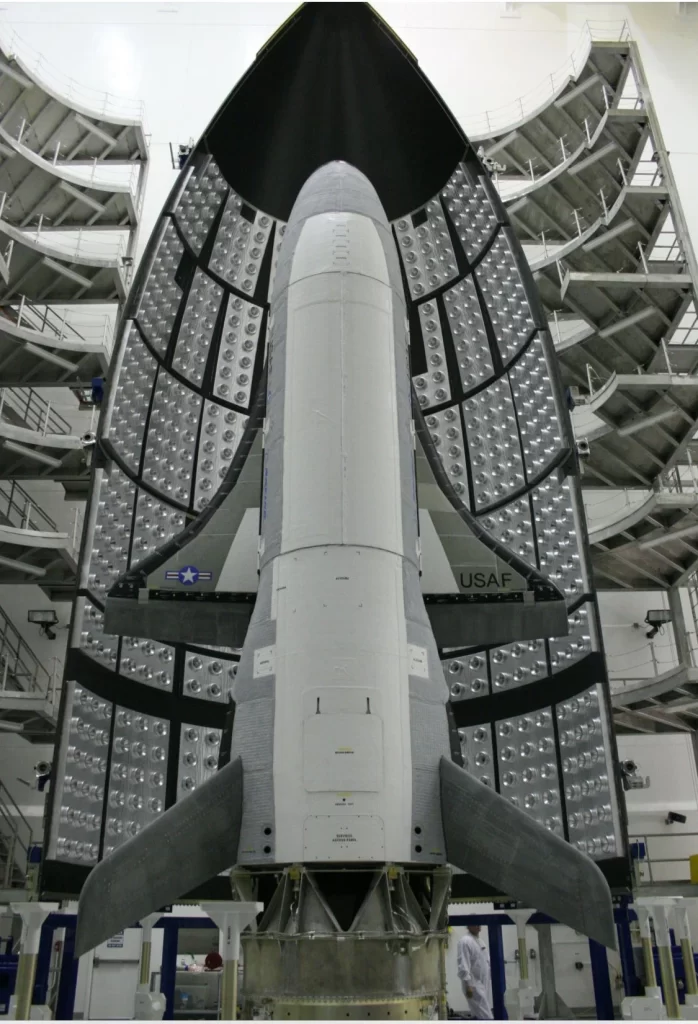On December 29, the mysterious American space drone X-37B successfully launched its seventh mission since 2010, following a delay of eighteen days. The sixth mission, completed in November 2022, was the longest in orbit, lasting nine hundred eighty-eight days. Officials from the United States Space Force (USSF) have yet to divulge the length of time that the orbiter will remain in the air or the contents of the spacecraft.
On December 11, X-37B was scheduled to launch aboard a Falcon Heavy rocket from Cape Canaveral, Florida. The countdown was stopped twenty-five minutes before the launch, and SpaceX claimed a “ground issue” without offering any other information.
Despite the secrecy of the mission, some things are known. According to explanations provided by the Pentagon at the time, the mission consisted of testing new materials, evaluating the effects of cosmic radiation on plant seeds (seeds 2 project), orbiting the FalconSat-8 microsatellite that was launched from the United States Air Force Academy, and putting into operation an experimental device that would capture solar energy and send it back to Earth in the form of a laser or microwave beam through which electricity would be generated.
There is some enigma regarding the seventh mission of the X-37B, particularly because the space drone will be placed in geostationary orbit for the first time. This is why the powerful Falcon Heavy launcher was selected for this mission. The USSF mentioned that they would be conducting experiments on future technologies related to space domain awareness and examining the effects of radiation on materials that NASA and the United States Space Agency provided.
The X-37B provides the United States with the necessary knowledge to improve ongoing and upcoming space missions. Specifically, according to General Bradley Chance Saltzman, Commander of the United States Space Force, Mission X-37B 7 exemplifies the USSF’s commitment to innovation and the definition of the art of the possible in space.
Despite this, the actions of the X-37B, which have demonstrated that it is capable of moving around in orbit, are largely kept secret. An individual previously serving as the United States Air Force secretary, Heather Wilson, stated that “it irritates our opponents.” It is also common knowledge that the Pentagon is contemplating affixing this space drone to the F-22 and F-35 fighter jets. This would enable the Pentagon to fulfil its mission of “operating in all domains.”
It is important to note that the Phantom Works branch of Boeing was responsible for the design of the X-37B, which had dimensions of 8.38 metres in length, 4.57 metres in wingspan, and 2.9 metres in height. In addition to being driven by a Pratt & Whitney Rocketdyne engine, it has an empty mass of around five tonnes.

According to Boeing, the X-37B is one of the world’s most cutting-edge re-entry spacecraft. It is meant to operate in low-earth orbit, between 150 and 500 miles above the surface of the Earth. The vehicle is the first one since the Space Shuttle that can bring experiments back to Earth for additional examination and analysis once they have been completed. This unmanned space vehicle operated by the United States Air Force was designed to investigate reusable technology that could serve long-term space goals.
This technique is utilised by more than just the United States military. Shenlong, also known as the Divine Dragon, is a space drone China put into orbit using a Long March 2F rocket launched from the Jiuquan Satellite Launch Centre. On December 14, China announced that it had successfully launched the space drone into orbit. Onboard the plane, China launched six unidentified objects into the orbit of the Earth, but no one has been able to identify what they are.
However, amateur astronomer and satellite tracking expert Scott Tilley, who has closely monitored the spacecraft since its launch, reports that it deployed six objects into space when it reached orbit; these objects appear to be transmitting various signals.
The U.S. Department of Defence has assigned designations An through F to each of the six orbital artefacts the U.S. Space Force monitors.
At least one of the objects seems to be tracking the spaceplane on purpose. Scott Tilley explains that the radio signals emanating from OBJECT A (the adjacent one) are associated with the prior emissions of the “leading” spaceplane due to the signal’s restricted data content.
He wrote on social media that the amateur astronomer deduced from analysing the signals that OBJECT B seems to be the spacecraft itself and that OBJECTS A and B are in relative proximity and follow the same orbit. The artificial signals OBJECTS D and E transmitted lack any discernible accompanying data.
Scott Tilley notes that, in contrast to the pulse signals that accompanied the initial missions of Chinese spacecraft 1 and 2, these radio pulses are fleeting and intermittent.
Considering their respective orbits, Tilley posits that A, D, and E could encounter each other on multiple occasions.
The enigmatic object’s deployment into near-Earth space by a Chinese secret spaceplane is not unprecedented. Before this year, SpaceNews reported that the U.S. Space Force was monitoring an object that had been released during the second mission of an experimental spacecraft.
Amidst its inaugural expedition in 2020, the spacecraft additionally conveyed an object into outer space throughout its two-day voyage. SpaceNews reports that the object maintained S-band transmissions for several weeks.
